

MARCH OF THE TITANS - A HISTORY OF THE WHITE RACE
CHAPTER 1 : IMPORTANT ISSUES
This book tells the story of White people as a racial group and not primarily of any specific geographic area. Hence the backdrop to this story jumps continents, ages and civilizations, linked only by the commonality of a genetic inheritance. Crucial to the understanding of the theme of this book is an understanding of the concepts of race, ethnicity and culture.
RACE, ETHNICITY AND CULTURE
A race is defined as a group of individuals sharing common genetic attributes which determine that group's physical appearance and, more controversially, their cognitive abilities. Ethnicity is defined as the creation of groupings by individuals (most often within racial groups but also possible across racial divides) of certain common traditions, languages, art forms, attitudes and other means of expression.
A culture is the name given to the physical manifestations created by ethnic groupings - the actual language, art forms, religion and social order and achievements of a particular ethnic group. In practical terms then, it is possible to talk of a White race; of a Scottish ethnicity and a Scottish culture. The last two - ethnicity and culture - are directly dependent upon each other, and in fact flow from each other in a symbiotic relationship. This book deals then primarily with White racial history, and flowing from that, White ethnic groupings and cultures.
THE WHITE RACE
What exactly is meant by the White race? Essentially there are three main sub groupings to the White race, with two further divisions of note. The three major sub groupings are known to academics as Nordic, Alpine and Mediterranean.
Although these names have come about mainly as a result of the geographic areas these sub groupings have been associated with in the Christian era (Nordics in northern Europe, Alpines in central Europe and Mediterraneans in southern Europe) it is incorrect to believe that these groupings always occupied these regions. These three main sub groupings have played a role in events in almost every geographical region where the White race as a group has appeared.
Of these three original groupings, only two are existent in any large numbers today: the Nordics and the Alpines. The original Mediterraneans of ancient history are not to be confused with those people loosely termed "Mediterranean" today - the present day inhabitants of the Mediterranean region are largely mixtures of several races, with the original White Mediterranean component for the greatest part having long since been submerged amongst invasions first of the Nordic and Alpine White sub-groupings, and then under Nonwhite Arabic, Turkish and other Middle Eastern and North African racial groupings.
To illustrate the concept of these three main sub groupings: although there is a broadly termed "Black race" in existence, there are major sub-groupings amongst that racial grouping: the Congo basin Pygmy and the ultra tall Masai tribesmen of Kenya are two good examples of sub groupings within the Black racial group.
A sub grouping is therefore a branch of a particular race which exhibits slightly different physical characteristics but still shares enough of a common genetic inheritance with other sub-groupings to be included in a broad racial category.
NORDIC
The Nordic sub racial grouping, which is still largely in existence to day, is characterized by light colored hair and eyes, a tall slim body build and a distinctive "long" (that is, thin and extended) skull shape.


The skull of a member of the Nordic White subrace, viewed from the front and the side. The long nature of the facial structure is clearly visible. Right: A classic Nordic male from Sweden.
ALPINE
The Alpine sub racial grouping, which also still exists in a large measure today, is characterized by brown hair and eyes, a short, more "solid" body build and a distinctive "round" (that is, almost, but not quite, circular) skull shape.


The skull of a member of the Alpine White subrace, viewed from the front and the side. The rectangular shape of the facial structure is clearly visible. Right: a classic Alpine male from southern Germany.
MEDITERRANEAN
The Mediterranean sub racial grouping virtually no longer exists today - the first of the three White racial sub-groupings to disappear from the earth, submerged into the gene pools of surrounding races. The Mediterranean sub grouping was predominantly (but not totally) characterized by dark hair and eye color, slim (Nordic) or solid (Alpine) body build and either long or round skull shapes.


The skull of a member of the Mediterranean White subrace, viewed from the front and the side. Right: as close an example of a true Mediterranean as is to be found in modern times: a First World War soldier from Wales in Britain.
MEDITERRANEANS VIRTUALLY EXTINCT
It is worth stating again, as it is of great significance in more ways than one, that there are very few of these original Mediterranean racial types left in the world today. They were known as the "Old Europeans" and inhabited large parts of Europe, Egypt, the Middle and Near East and Egypt at the dawn of history.
These Mediterranean types bear almost no resemblance to the present day inhabitants of the Mediterranean basin: the original Old Europeans have been absorbed almost completely into either the Nordic/Alpine stock in Europe itself, or the African/Semitic/Asian stock of North Africa, the Near and Middle East.
The only place in Europe where occasional glimpses of this original Mediterranean sub racial grouping can still be seen, is in the Celtic fringes of Britain, most notably in Wales and Devonshire, and in the Basque territory of Spain. In these regions there exists a short dark strain - remnants of the original inhabitants of Europe.
Pure examples of this Mediterranean type are however still fairly rare, as even they have for the largest degree had some Nordic or Alpine admixture over the years.
OTHER SUB-GROUPINGS
Two other White racial sub groupings exist (called Dinarics and East Baltics) - these groupings are to the largest degree the result of mixtures of the three main sub groupings. The Dinarics and East Baltics are found in large numbers in present day Eastern Europe, and exhibit Nordic, Alpine and Mediterranean physical characteristics.
A very small percentage of these two sub-groupings also display the physical characteristics resulting from physical mixing with the waves of Asiatic invaders who penetrated Europe from the east during the course of history: this issue is discussed in full later in this book.
GENETIC UNITY
For the purposes of this book, an ethnic or cultural group is defined as part of the White race as long as it shares for the greatest part enough of a common genetic inheritance with the broad racial group. When such an ethnic group loses this genetic commonality (as has happened to the Mediterraneans) it is then formally excluded from the broad White racial category.
MEANS OF TRACKING RACE IN CIVILIZATION
How is race tracked in civilization? How is it determined whether the populations of certain societies or civilization belonged to specific races? The answer to this is simple: race in history is tracked in three ways: palaeoserology, art forms and language.
PALAEOSEROLOGY
Palaeoserology is the study of skeletal remains - physical remains of people who died during the time periods under study. As different racial groups have different physical characteristics, it is a relatively simple matter to determine the racial make-up of the inhabitants of a particular region by studying the contents of grave sites.
This skill is today often used by modern police pathologists in identifying the race of unidentified corpses, and this science has proven equally useful in historical diggings.
The process of examining burial sites and corpses has proven invaluable in creating an understanding of the racial make-up of the peoples who lived in different areas at different times when there are no other indicators as to their racial origins.
ART FORMS
Art forms (artistic illustrations, be they conventional pictures or illustrations on pottery; or even statues) also provide significant indicators of the racial make-up of contemporary inhabitants.
The ancient civilizations in particular - of all racial groupings - reflected themselves in their art forms (often because their own racial types were the only human models from which they had to work).
In this way for example, early Chinese art depicted principally Chinese people, Inca and Aztec art depicted only Inca or Aztec people, and so on. In virtually all societies, original art forms portraying people closely followed contemporary physical appearances. This principle is well illustrated in the four art forms portrayed above.

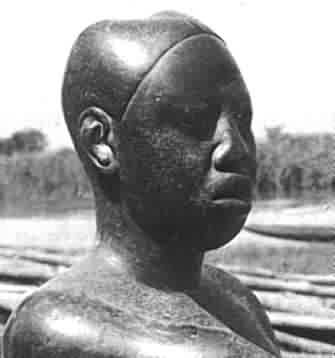


Tracking race in history: race depicted in art forms. Early civilizations very often depicted images of their own racial types in their works of art, based on the reality that their own types were the most common (or only) human models they had to work with. A comparison of (from left to right) Olmec art, 400 BC; African art,circa 1400 AD; Japanese art, 1,000 AD; and Greek art, 340 BC; reflects this principle well. The study of art forms is a reliable indicator of the racial type of the communities in which the art works were created.
LANGUAGE
The study of language is another important clue in the dispersion of peoples: commonalities in language forms leave clearly identifiable "fingerprints" in cultures.
Similar words, phrases or language forms are a clear indication of a single origin for civilizations, due to the fact that the people in those civilizations would at some stage have had a common origin.
In this way the route of a culture (and hence a people) can be traced by following a language.
| English | German | Latin | Greek | Old Persian | Sanskrit |
| brother | bruder | frater | bhrater | brater | bhrater |
| mother | mutter | mater | meter | matar | matar |
| father | vater | pater | pater | pitar | pitar |
CLIMATE AND GENES
The argument of climatic influence as a cause of physical racial differences is as flawed as the belief in a common racial ancestor.
Often the argument is heard that the White race has its color because it originated in the cold north, and that the Black race has its color because it originated in the hot south. Apart from the obvious geographical impossibility of this conjecture (because of the fact that many of the White race's greatest achievements were made in a hot climate - the Near East and Egypt) this argument does not explain why for example members of the Mongolian races (Chinese, Japanese and others) have their distinctive racial characteristics.
How did the climate of Asia for example create the distinctive eye shape and skull structure by which Mongolian races are known?
The reality is that physical characteristics are genetically determined at the moment of conception, and there is absolutely no evidence to indicate that living in a cold or a hot climate changes the genetic make up of a group of people. If a large group of Chinese people had to move to Norway, live there for any length of time, all the while remaining (marriage and children wise) within their racial group, will anyone seriously suggest that they will "evolve" into blue eyed blond people over any period of time?
The same argument can be used in reverse: who will seriously contend that Whites moving to China, (as remaining within their own genetic community, not interbreeding with the local population) will become Mongolian in physical appearance after any length of time?
People may grow a little taller, or live a little longer with better nutrition or medical services, but this is merely an extension of the genetic potential of those people, rather than a change in the genes themselves. Climate then can never change the gene pool of a people.
The only way a gene pool can be changed is if enough members of that gene pool physically mix - physically integrate and have offspring with - a gene pool outside of that original group. This is the only way in which genes can "change" - and history is full of examples of where this has happened, where original racial groups have integrated with other previously separate racial groups to produce new groupings having overall different physical and even cognitive characteristics from both the original parent groupings.
ENVIRONMENT AND ACHIEVEMENT
Another popular modern myth is that some racial groups developed faster than others because of the accident of their geographic location. This is known collectively as the environmental theory of development: that because some races were "lucky" enough to live around, for example, fertile river basins, or had access to certain types of domesticable animals or edible plants, that they developed faster than other racial groupings elsewhere in the world.
This world view attempts essentially to explain the huge technological gap which existed between the White Europeans and the Black Africans, Native Americans (Amerinds), Asians and Australian Aborigines, at the time of the period of White exploration and colonization of the world.
While it is not the purpose of this book to delve into what are after all, subjective notions of superiority and inferiority (what is regarded as superior by some can be regarded as inferior to another) nonetheless the issue of the technological gap between the races needs addressing, if only because it played such a huge role in the history of the White race's interaction with the other races of the world.
The "environmental" theory as expounded by modern sociologists is destroyed by two main examples: Egypt - and a comparison between the indigenous cultures of Equatorial Africa and Central America.
In Egypt, as will be shown, the Black and White races shared what was virtually an identical geographic location along the banks of the Nile River - yet despite this the ancient White Egyptians produced a civilization which is still a marvel of world history; while the achievements of the Black (Nubian) inhabitants of the same region are distinctly unremarkable in comparison to the wonders of the pyramids.
If the "lucky environmental accident" were true, then the vast difference between the original White Egyptians and Black Nubians should never have come about, as they shared an identical environment.
Often the argument is made that Whites had an advantage because they had pack animals and horses while the native peoples did not - this argument ignores the fact that the White Egyptians did not have horses until long after the creation of many of their finest apexes of technological marvels. In fact horses were introduced to Egypt by the Semitic Hyksos invasion which occurred hundreds of years after the first flowering of Egyptian civilization.
COMPARISONS
It is of value to compare the achievements of the Nonwhite Inca and Aztec Amerind peoples in Central and South America, lying just north and south of the equator, with that of the original heartland of the Black race, also just north and south of the equator in Africa. Due to the proximity to the equator, virtually identical environmental conditions prevailed (and still prevail) in Central America and Central Africa. Neither region had horses, and both had the challenges of the equatorial rain forest with which to deal.
Despite the similarity in environment, the Amerinds in Central America were able to build sophisticated buildings, establish written forms of communication, establish gold and precious metal working and a host of other advances: while in Africa little or no progress beyond the Stone Age was made.
The disparity between the Nonwhite Amerinds and the Nonwhite Africans cannot be explained by the "accident of geography".
Lastly, and most devastatingly, the "environment" argument falls flat when measured against the rise and fall of civilizations. Why is it that Ancient Egypt at one stage led the world in culture and civilization, yet today is a majority backward Third World country?
If environment alone gave certain peoples a "permanent advantage" then it would surely follow that Egypt would today be one of the most advanced countries in the world.
In reality it is, as any visitor to that land will testify, filled with misery, poverty and backwardness - despite the "environment" being exactly the same as it was during the great age of the civilization which built the pyramids.
The "environmental" theory does therefore not explain why Egypt, with exactly the same environmental conditions, could have lost its preeminence over the rest of the world.
TECHNOLOGICAL GAP - REASONS
Just what caused the technological gap then? If environment did not cause it, the only other logical explanation must be that certain types of culture, or civilization, are the products of certain types of people - representative of the innate potential of any given group of people. While this is presently deemed a politically incorrect point of view, the facts of historical development support no other conclusion.
One further example - the progress of North America can be compared with that of South America. North America was for the greatest part colonized by White Europeans, and subsequently became the leading power in the modern world. South America, on the other hand, having far richer natural resources than North America, was never majority colonized by White Europeans and today has a majority mixed race population.
This continent is classed as Third, or at best Second World. Clearly, if environment were the only factor determining levels of achievement, South America should in theory be more advanced than North America, having far more "environmental advantages" than North America.
HOMO ERECTUS
Archaeology and its allied science, palaeoserology, have revealed that life forms in the general shape of humans (that is, two arms, two legs, a torso, a head and walking upright on the two legs) appeared in different places across the earth approximately two million years ago. These were the "Homo Erectus" (or "upright man") racial types so favored by evolutionists as the "ancestors of man". These creatures have been found scattered throughout Europe, Africa, China and Australia. It remains however speculative to say with any certainty that modern man is descended from any of these Homo Erectus racial types.
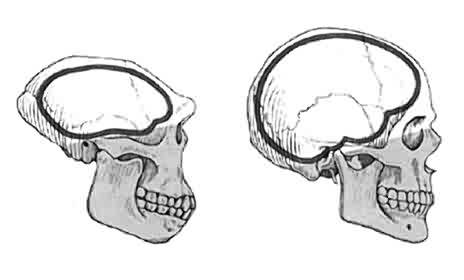
A comparison between the skull of a Homo Erectus type (left) and that of a Homo Sapiens (right) shows the difference in cranial size and facial angle which serves as an outstanding marker of the huge distance between the two racial types. Such vast differences call into question the theory that modern White racial types are descended from any previous racial groups, in particular the "Out of Africa" myth.
NEANDERTHAL
The time of the Homo Erectus types is known as the Paleolithic age. This age is deemed to have come to an end coinciding with the appearance of Neanderthal man, a new racial type, typified in modern imagery as the "ape man". Although Neanderthal man was slow witted, he was an advance on Homo Erectus. Once again, however, there is no clearly established link to modern White racial types.
Neanderthal man's physical characteristics were epitomized by the heavy browed skull and generally his arms were longer in relation to his body size. He was prognathic - which means that the forehead slopes back and the teeth stick out significantly - usually further than the furthest point of the nose or the chin.
CRO-MAGNON - THE FIRST MODERN WHITE RACIAL TYPE
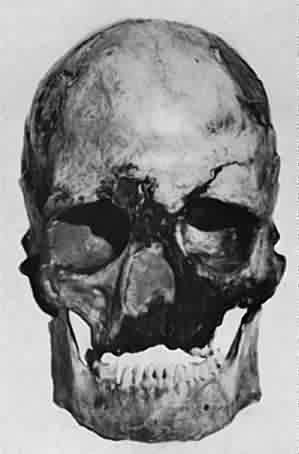
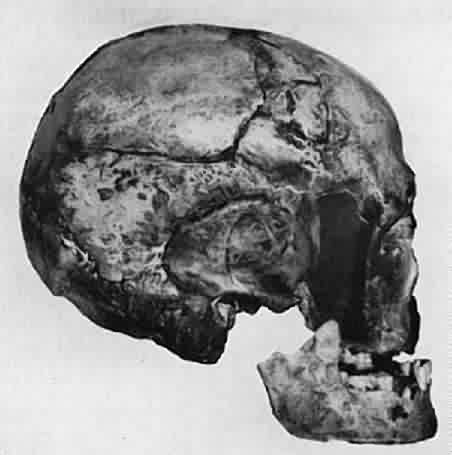
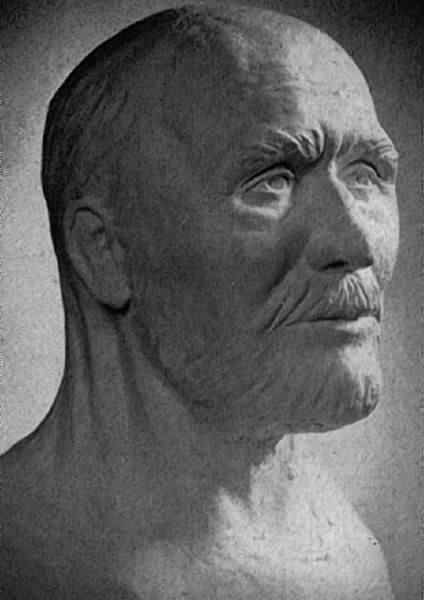
Above left and center: Cheddar Man. The well preserved skull of a complete example of Cro-Magnon man, discovered in the Cheddar Gorge in England. The skeleton is between 40,000 and 30,000 years old. Right: A flesh reconstruction bust of Cro-Magnon man, made by the famous anthropologist, Maurice Putnam Coon. It is from the emergence of Cro-Magnon man that recorded White history begins.
The first modern White racial type only emerged between approximately 40,000 BC and 15,000 BC in differing parts of Europe and the Near East. This time period is known as the Late Paleolithic period, also known generically as the Stone Age. This first racial type is known as Cro-Magnon man - after a site in the Dordogne region of France where the first skeletal remains were found.
Cro-Magnon man is the first biped life form with whom modern Whites can clearly claim a direct genetic affinity. White racial history therefore begins around the year 35,000 BC - and so it is with the Late Paleolithic period that the story in this book really begins.
or back to
or
All material (c) copyright Ostara Publications, 1999.
Re-use for commercial purposes strictly forbidden.